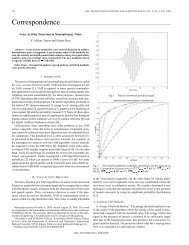Thesis (PDF) - Signal & Image Processing Lab
Thesis (PDF) - Signal & Image Processing Lab
Thesis (PDF) - Signal & Image Processing Lab
Create successful ePaper yourself
Turn your PDF publications into a flip-book with our unique Google optimized e-Paper software.
5.1. THE COMPLETE INF-SEMILATTICE OF TREE REPRESENTATIONS 65<br />
Figure 5.4: An example of trees intersection that is not a tree.<br />
The intersection is given by t1∩t2 = ({r, a, d}, {ra}), which has two connected compo-<br />
nent: ({r, a}, {ra}) and ({d}, {}). Notice, however, that only one of these components<br />
contains the root r, and it is in fact the largest tree with root r that is included both<br />
in t1 and in t2. That is, the sub-tree containing r is the infimum between the two<br />
trees regarding the inclusion order.<br />
This is true in general. That is, if we define Cr(·) to be the operator that extracts<br />
from a given graph its connected component containing the root r, then Cr(t1 ∩ t2)<br />
is the infimum t1 ∧ t2 between the trees.<br />
Let us turn now to the infimum of mapping functions. It is natural to consider<br />
M1(x) � M2(x) as the natural candidate for the infimum of the two vertices M1(x)<br />
and M2(x). But, in which tree should this infimum be calculated? Should it be in t1,<br />
t2, t1 ∧t2, t1 ∪t2? The infimum t1 ∧t2 is correct, but it may occur that either M1(x) or<br />
M2(x) (or both) do not belong to its set of vertices V (t1 ∧ t2). For instance, consider<br />
the trees t1 and t2 as in the example above, and assume that M1(x) = b and M2(x) = c<br />
as shown in Figure 5.5. Neither M1(x) nor M2(x) belongs to V (t1 ∧ t2) = {r, a}.<br />
The solution to this problem is to first “project” each vertex M1(x) and M2(x) to<br />
V (t1 ∧ t2), and then to take the infimum of the projected vertices on the tree t1 ∧ t2.<br />
By “projection” of a vertex v onto a subtree t ′ ⊆ t we mean finding the vertex w in<br />
V (t ′ ) that is the closest to v in the path connecting v to r inside t ′ . For instance, in<br />
the above example, the projection of both M1(x) = b and M2(x) = c onto t1 ∧ t2 is<br />
a. Recalling that vtr represents the path linking v to r in the tree t, the projection<br />
Pt ′(v) of v onto the subtree t′ could be also defined as the leaf of Cr(vtr ∩ t ′ ).<br />
In summary, we get the following proposition.
















